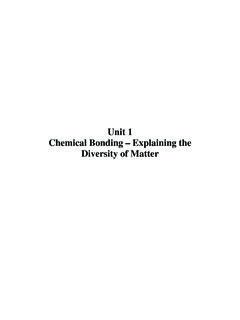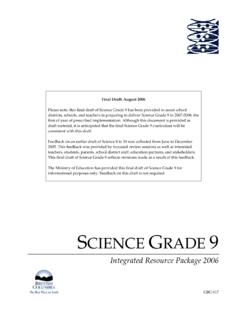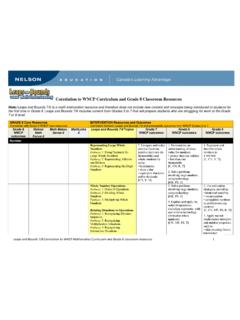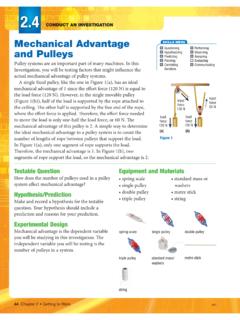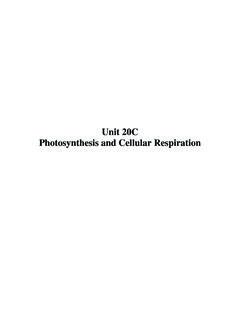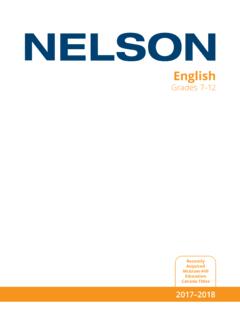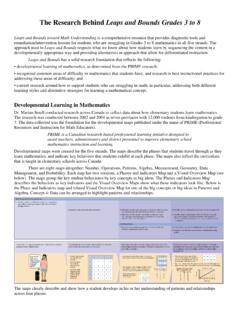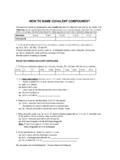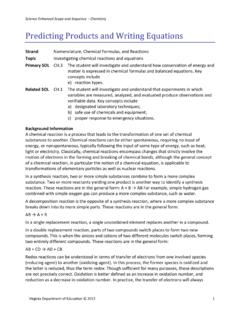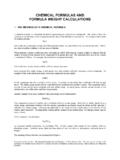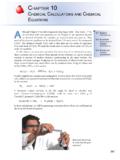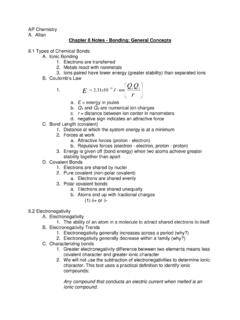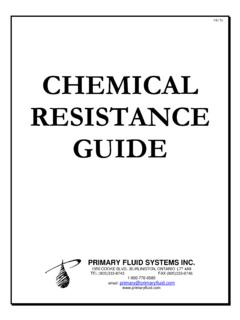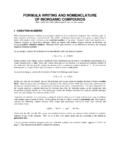Transcription of Unit 5 Organic Chemistry - Nelson
1 Unit 5 Organic Chemistry 55unitOrganic ChemistryOrganic Chemistry352 Unit 5 NEL Syncrude Canada was just about to begin operating itsoil sands plant when I was graduating. I had attended sev-eral talks about the oil sands, so my primary reason forinterviewing with the company was to see their pilotplants. When they offered me a job, however, I of the advantages of working in such a large com-pany is that I have had the opportunity to carry outresearch in numerous areas. I like the variety of the I joined the work force, I was concernedwhether I had the correct qualifications for the job. I havesince learned that my formal training was really just thebeginning of my learning. What I learned in school ishow to approach a problem. On the job, I ve expandedmy knowledge and learned how to work in diverse teamsto solve our problems. As you progress through the unit, think about these focusing questions: What are the common Organic compounds and what is the system for namingthem?
2 How does society use the reactions of Organic compounds? How can society ensure that the technological applications of organicchemistry are assessed to ensure future quality of life and a sustainableenvironment?Jean Cooley, Research Associate,Syncrude Canada Unit 5 - Ch 09 CHEM30 11/2/06 11:24 AM Page 352 Organic Chemistry353 GENERAL OUTCOMESIn this unit, you will explore Organic compounds as acommon form of matter describe chemical reactions of organiccompounds NELUnit5 Unit 5 - Ch 09 CHEM30 11/2/06 11:24 AM Page 353 Unit 5 ARE YOU READY?354 Unit 5 NELP rerequisitesOrganicChemistryKnowledge1. According to Lewis theory, the number of bonding electrons in an atomdetermines the number of bonds the atom will form. Complete Table 1for fiveelements that are often involved in Organic 1 Atomic Structures of Some Common Nonmetals Number ofNumber ofAtomicNumber ofvalenceLewisbondingElementnumberelectr onselectronssymbolelectronscarbonhydroge noxygennitrogensulfur2.
3 Different formulas for molecules can be used to predict the types ofintermolecular bonding that exist in a substance. Complete Table 2for somecommon compounds of 2 Some Common Carbon Compounds Types of MolecularLewisStructuralintermolecularIU PAC nameformulaformulaformulaforcesCH4(g)dic hloromethaneCH2Cl2(l)methanolmethyl amineCH3NH2(l)ethaneetheneC2H4(g)ethyneC 2H5OH(l)ethyl mercaptanC2H5SH(l)3. Use VSEPR theory to predict the shapes of each of the following whether each molecule is polar or nonpolar.(a) chloromethane, CH3Cl(g), used as a refrigerant(b) carbon dioxide, CO2(g), produced by hydrocarbon combustion(c) formaldehyde, HCHO(g), used as a disinfectant(d) ethyne, C2H2(g), used as a fuel for welding(e) ethene, C2H4(g), used to make plastics 4. The octane used in automobile fuel is considered nonrenewable because it isproduced from petroleum, a fossil fuel. Ethanol is considered a renewable fuelsince it can be produced from biomass, such as grain.(a) Write a balanced chemical equation for the combustion of octane, C8H18(l).
4 (b) Write a balanced chemical equation for the combustion of ethanol,C2H5OH(l).(c) Describe some diagnostic tests for the reaction products in (a) and (b).Concepts atomic structure physical and chemicalproperties of molecularcompounds covalent bonding polar and nonpolarmolecules intermolecular forcesSkills drawing diagrams andwriting formulas ofmolecules building molecular models conducting and analyzingdiagnostic tests describing safety anddisposalYou can review prerequisiteconcepts and skills in theChemistry Review unit, onthe Nelson Web site, and inthe Unit Pre-Test is alsoavailable 5 - Ch 09 CHEM30 11/2/06 11:25 AM Page 354 Unit 5 Organic Chemistry355 NEL5. Photosynthesis is the formation of carbohydrates and oxygen from carbondioxide, water, and sunlight, catalyzed by chlorophyll in the green parts of aplant (Figure 1).(a) Write a balanced chemical equation for photosynthesis, using C6H12O6(aq)for the carbohydrate.(b) During summer in the Northern Hemisphere, the level of carbon dioxide inthe atmosphere decreases slightly.
5 Use the chemical equation in (a) toexplain this 6. Boiling point is a measure of the strength of the intermolecular forces in asubstance. There is evidence to suggest that London forces exist among allmolecules in the liquid or solid state. Chemists explain the strength of Londonforces as being dependent on the number of electrons in the molecule. Polarmolecules exert relatively weak dipole dipole forces in addition to Londonforces. Molecules with OH, NH, or FH groups have relatively strong hydrogenbonds in addition to London forces. The purpose of this activity is to test theability of the theoretical concepts of London forces, dipole dipole forces, andhydrogen bonding to predict the relative boiling points of three families ofcompounds. Complete the Prediction, Analysis, and Evaluation (2, 3) of theinvestigation are the trends in boiling point for three families of carbon compounds?DesignThe boiling points of twelve Organic compounds (from three chemical families)are measured experimentally.
6 The boiling point evidence is used to test thePrediction. The polarity of the molecules and the hydrogen bonding arecontrolled variables within each family of Liquid hydrocarbons are readily flammable and often evaporate easily to formexplosive mixtures with air.(a) What WHMIS symbol is found on a container of a liquid hydrocarbon?(b) Outline the precautions that must be taken when working with liquidhydrocarbons.(c) Describe an acceptable method for handling waste flammable 1 Photosynthesis consumes carbondioxide and produces 3 Boiling Points of Three Families of Carbon Compounds BoilingOrganicBoiling Boiling Hydrocarbonpoint ( C)halidepoint ( C)Alcoholpoint ( C)CH4(g) 164CH3Cl(g) 24CH3OH(l)65C2H6(g) 89C2H5Cl(g)12C2H5OH(l)78C3H8(g) 42C3H7Cl(l)47C3H7OH(l)97C4H10(g) (l)78C4H9OH(l)117 Unit 5 - Ch 09 CHEM30 11/2/06 11:25 AM Page 35599 Hydrocarbons fromPetroleumchapterHydrocarbons fromPetroleum356 Chapter 9 NELThe most widely accepted explanation of the origin of fossil fuels is that they come fromdecaying plant and animal material.
7 The carbon cycle is a model connecting the organicreactions of photosynthesis, digestion, and respiration (Figure 1). The formation offossil fuels can be seen as the end of the natural processes in the carbon cycle and the begin-ning of the technological processes described in this have invented methods to extract fossil fuels from below the surface of mostly burn fossil fuels to produce heat and useful energy. These combustion reac-tions produce carbon dioxide, which feeds back into the carbon , we have developed many other technological uses of fossil fuels. We nowproduce vast quantities of petrochemicals (chemicals created from fossil fuels), most ofwhich are not meant to be burned. Petrochemicals include methanol (windshieldantifreeze), ethylene glycol (radiator antifreeze), chlorofluorocarbons (CFCs: refrigeratorand air conditioner coolants), plastics (polyethylene and polyvinylchloride (PVC)), andpesticides. In this chapter, you will learn about the extraction and refining of fossil the next chapter, you will learn about the use of fossil fuels to create both uses, fossil fuels are a very valuable nonrenewable resource.
8 The impact offossil fuel use on our lives and our planet is everywhere around , natural resources were seen as assets to be developed, and it was usualto imagine technological solutions to problems. In recent times, however, we have cometo realize that technology is limited in its ability to cope with resource depletion andpollution. Many people, including scientists, believe we need to move toward an Aboriginalviewpoint that sees natural resources as gifts to be treasured for future generations. Inorder to save our planet from irreparable harm, we have a responsibility to live in har-mony with nature for the mutual benefit of nature and this chapterCareer Connections: Petroleum Engineer; The Petroleum IndustryAnswer these questions as best you can with your current knowledge. Then, usingthe concepts and skills you have learned, you will revise your answers at the end ofthe are the origins and sources of fossil fuels? are fossil fuels extracted and refined?
9 Are the main hydrocarbon families, and how do they differ? are some uses of fossil fuels and their components? STARTING PointsExploration: BurningFossil FuelsInvestigation :Classifying Fossil Fuels Case Study: Fossil FuelIndustries in Alberta Web Activity: Coal inAlbertaExplore an Issue: CoalbedMethaneInvestigation :Structures and Propertiesof IsomersWeb Activity: West NileDenialLab Exercise : chemical Properties ofAliphatics and AromaticsLab Exercise : BoilingPoints of SampleAliphatics and AromaticsInvestigation :Fractional Distillation(Demonstration)Web Activity: KarlChuangCase Study: OctaneNumberInvestigation : Bitumenfrom Oil SandsInvestigation : SolventExtractionCase Study: TheAthabasca Oil SandsInvestigation :Complete and IncompleteCombustionUnit 5 - Ch 09 CHEM30 11/3/06 10:11 AM Page 356 Hydrocarbons from Petroleum357 NELF igure 1 The carbon cycle is an illustration of the interrelationship of all living things with theenvironment and with technologies that refine and use fossil Fossil FuelsScientists agree that fossil fuels are a nonrenewable, finiteresource.
10 Fossil fuels in Alberta include coal, natural gas, crudeoil, oil sands, and heavy oil. Studies have indicated that about95% of the fossil fuels used in Alberta is used for energyproduction, including natural gas and propane for homeheating, and gasoline and diesel fuel for cars, trucks, and evidence indicates that about 5% of fossil fuels is convertedinto petrochemicals (such as plastics) through technologiesbased on chemical reactions. Two issues related to burningfossil fuels for energy production are whether we should be burning a very valuable resource atthe current rate whether we should be saving more of this resource forpetrochemical use in the futureInvestigate the first of these issues as you work through Chapter 9, and the second issue in Chapter : The burning of fossil fuels for heat andtransportation should be significantly progressing through Chapter 9, complete the Design,Evidence, Analysis, and Evaluation components of the first , industry, and citizens alike speak of sustainabledevelopment.
